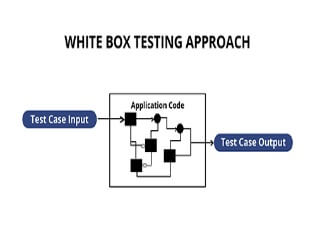Advantages and Disadvantages of White Box TestingTraditionally, there has been a distinct division between developers and quality assurance testers in the software development process. To ensure that the functionality they have developed satisfies the requirements, developers install functionality and conduct QA tests. Black-box testing is the term for this kind of testing carried out by QA. With black-box testing, functionality is tested without knowledge of the system's inner workings. White-box testing, in contrast, is carried out by a person who is well-versed in the internals. White Box TestingA chunk of code is run during a white-box test case with predetermined input values to confirm predetermined output values. A bug is discovered if these values do not match. This is stated numerous times throughout the application. White-box testing aims to confirm:

In white box penetration testing, the tester/developer is fully aware of the application's source code, comprehensive network information, all relevant IP addresses, and all server information the application uses. In order to uncover security risks, it is intended to attack the code from many sides. White box penetration testing entails looking for security flaws in the internal code, enhancing security by making it more aesthetically pleasing and functional, and fixing poorly organised development routes. It includes comparing numerous defined inputs with anticipated outputs. In order to find security flaws or hazards as quickly as possible, this technique is helpful. The most crucial component of the white box testing approach is the code coverage analysis, which enables a team of software engineers to identify areas of code that a particular set of test cases doesn't really run, hence enhancing the quality of a software programme. The analysis of code coverage can be done using a variety of methodologies. These include:
The various advantages and disadvantages of White Box Testing that are listed below: Advantages of White Box TestingThe completeness, automation, time savings, optimization, and introspection of white box testing are its benefits. 1. Thoroughness Complete code coverage is the fundamental tenet of white-box testing. The basic concept is to test as much code as you can, which is far more thorough than standard black-box testing. White-box testing's thoroughness also lends it a distinct framework. The rules of testing must be precise, engineering-based, and well-defined. This type of testing is transparent, it is possible to do thorough tests that cover all possible paths as well as the complete structure and code base. It evaluates internal and external vulnerabilities as well, which could aid in preventing future security threats and assaults. 2. Unit Testing Unit testing is made possible by understanding the application's internal workings. As the name implies, unit tests examine single lines of code, or units, to determine whether they function as intended. These tests are easy to perform programmatically, allowing developers to rapidly determine whether something is broken. Unit tests are a useful tool for determining whether a previously functioning component has recently broken. 3. Time Time management is a top responsibility during the software development process because there are constant deadlines to satisfy. White-box testing has the ability to drastically speed up the testing process. Developers frequently have a general understanding of the problem and the best way to resolve it as soon as they discover a fault. The expense of communication between developers and QA is also eliminated by white-box testing because developers can identify and address problems without waiting for QA. 4. Optimization A section-by-section analysis of the code enables developers to eliminate unnecessary code or condense already-existing code. Additionally, by removing obfuscated problems that can go undetected during routine testing, code can be made more efficient. 5. Introspection White-box testing enables programmers to thoroughly consider implementation. Developers are compelled to think about the relationships between different pieces of code. Perhaps the existing implementation is adequate but will not scale well in the future or contains extraneous components that can be removed. Developers can review designs and consider how they might be improved by using white-box testing. Disadvantages of White Box TestingWhite-box testing has drawbacks including high cost, frequently changing code, and missing cases. 1. Expensive White-box testing becomes highly time and money-consuming to undertake as it is more thorough. Although this is somewhat mitigated by unit testing, writing the unit tests requires an initial investment. Additionally, this kind of testing may not scale well with huge applications. Testing every code version becomes very difficult. White-box testing necessitates competent testers who are familiar with programming, in contrast to black-box testing. This drives up the cost and may discourage developers from working on additional features. White-box testing must take all of these costs into account. 2. Code base that changes quickly If the code base is changing quickly, automated test cases are useless. Most written test cases are frequently useless after redesigns or rework and require rewriting. If the implementation changes frequently, an updated test script is necessary. 3. Incomplete cases Only existing functionalities are validated and tested during white-box testing. White-box testing won't detect a feature that is only partially implemented or that has certain components missing. Black-box testing that is driven by requirements excels in this area. 4. Time consuming When employing the white box testing approach for large applications, exhaustive testing becomes even more difficult. White box testing takes a lot of time because it requires creating a wide range of inputs to test every possible path and circumstance. 5. More errors It is not realistic to test every condition, thus some might go untested. With the general method of analysing each line by line or path by path, errors in the code might not be found or might even be introduced. |
 For Videos Join Our Youtube Channel: Join Now
For Videos Join Our Youtube Channel: Join Now
Feedback
- Send your Feedback to [email protected]
Help Others, Please Share










